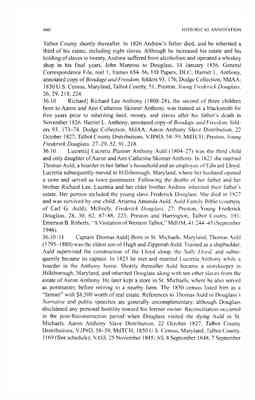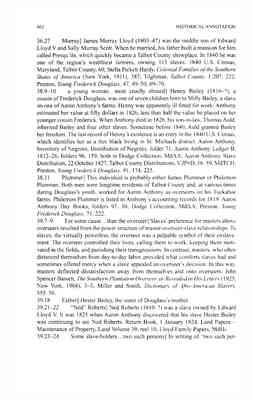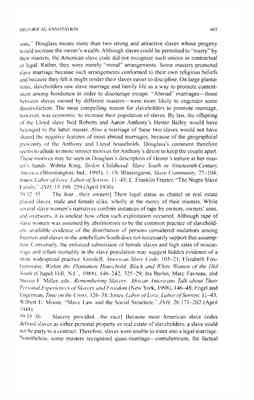Pages
31
HISTORICAL ANNOTATION 659
House is a large wood-frame building, constructed in the "five-part" design, with a central block and corridors on each side and another wing at the end of each corridor. Douglass visited there in June 1881, and several younger members of the Lloyd family escorted him around the grounds. Footner, Rivers of the Eastern Shore, 271; Preston, Young Frederick Douglass, 192-96. 33.34 "none to molest them or make them afraid."] Micah 4:4. 34.15-17 business of twenty. . .than a thousand] Edward Lloyd V owned numerous plantations and farms in Louisiana, Arkansas, and Mississippi, as well as across Maryland. Historical sources estimate that he owned in excess of 700 slaves. Preston, Young Frederick Douglass, 42-43. 34.21-22 Georgia traders] Douglass probably refers to slave traders from states in the Lower South, such as Georgia. Major slave traders would ship their "cargo" by water to southern ports such as Savannah, Charleston, or Mobile, although New Orleans was the predominant destination. Austin Woolfolk was the leading trader in Maryland and northern Virginia in the 1820s and 1830s and was known by reputation to slaves throughout the region. Winfield H. Collins, The Domestic Slave Trade of the Southern States (1904; Port Washington, N.Y., 1969), 100-05; Miller and Smith, Dictionary of Afro-American Slavery, 686-88. 34.26 "Uncle" Harry] Henry Bailey (1820-?) was the youngest of twelve children born to Douglass's maternal grandparents, Isaac and Betsey Bailey. Henry was owned by Aaron Anthony of Talbot County; when Anthony died in 1826. Henry became the property of Richard Lee Anthony. When Richard died in 1828, Thomas Auld, Richard's brother-in-law, became Henry's master. Aaron Anthony Slave Distribution, 22 October 1827, Talbot County Distributions., V.JP#D, 58-59, MdTCH; Preston, Young Frederick Douglass, 18, 109, 206. 35.15 epsom salts and castor oil] Epsom salts (the popular name for magnesium sulfate), castor oil, laudanum, paregoric, sugar of lead, and mercurial ointment were common treatments for ailments in the early nineteenth century. Elizabeth Barnaby Keeney, "Unless Powerful Sick: Domestic Medicine in the Old South," in Science and Medicine in the Old South, ed. Ronald L. Numbers and Todd L. Savitt (Baton Rouge, La., 1989), 286-88; Miller and Smith, Dictionary of Afro-American Slavery, 313. 35.16 "Lord's prayer."] The modern name given to the prayer offered by Jesus and taught to his disciples. as related in Matt. 6:9-13 and Luke 11:2-4. The prayer contains petitions relating to the fulfillment of God's will and to human needs. David Noel Freedman et al., eds., The Anchor Bible Dictionary, 6 vols. (New York, 1992). 4:356-62. 36.9 Andrew] Andrew Skinner Anthony (1797-1833) was the eldest son of Aaron and Ann Catherine Skinner Anthony and the nephew of Edward Lloyd V. His father apprenticed him as a young man to James Neall, a cabinetmaker, in Easton, Maryland. After completing his apprenticeship, Anthony migrated to Indiana, where he married Ann Wingate of Martin County in 1823. He and his bride returned to
32
660 HISTORICAL ANNOTATION
Talbot County shortly thereafter. In 1826 Andrew's father died, and he inherited a third of his estate, including eight slaves. Although he increased his estate and his holding of slaves to twenty, Andrew suffered from alcoholism and operated a whiskey shop in his final years. John Manross to Douglass, 14 January 1856, General Correspondence File, reel l, frames 654-56, FD Papers, DLC; Harriet L. Anthony, annotated copy of Bondage and Freedom, folders 93, 176, Dodge Collection, MdAA; 1830 U.S. Census, Maryland, Talbot County, 51; Preston, Young Frederick Douglass, 26, 29, 218, 224. 36.10 Richard] Richard Lee Anthony (1800-28), the second of three children born to Aaron and Ann Catherine Skinner Anthony, was trained as a blacksmith for five years prior to inheriting land, money, and slaves after his father's death in November 1826. Harriet L. Anthony, annotated copy of Bondage and Freedom, folders 93, 173-74, Dodge Collection, MdAA; Aaron Anthony Slave Distribution, 22 October 1827, Talbot County Distributions, V.JP#D. 58- 59, MdTCH; Preston, Young Frederick Douglass, 27-29, 52, 91, 218. 36.10 Lucretia] Lucretia Planner Anthony Auld (1804-27) was the third child and only daughter of Aaron and Ann Catherine Skinner Anthony. In 1823 she married Thomas Auld, a boarder in her father's household and an employee of Edward Lloyd. Lucretia subsequently moved to Hillsborough, Maryland. where her husband opened a store and served as town postmaster. Following the deaths of her father and her brother Richard Lee, Lucretia and her older brother Andrew inherited their father's estate. Her portion included the young slave Frederick Douglass. She died in 1827 and was survived by one child, Arianna Amanda Auld. Auld Family Bible (courtesy of Carl G. Auld); McFeely, Frederick Douglass, 27; Preston, Young Frederick Douglass, 28, 30, 62, 87-88, 223; Preston and Harrington, Talbot County, 191; Emerson B. Roberts, '"A Visitation of Western Talbot," MdHM, 41:244-45 (September 1946). 36.10-11 Captain Thomas Auld] Born in St. Michaels, Maryland, Thomas Auld (1795-1880) was the eldest son of Hugh and Zipporah Auld. Trained as a shipbuilder, Auld supervised the construction of the Lloyd sloop, the Sally Lloyd, and subsequently became its captain. In 1823 he met and married Lucretia Anthony while a boarder in the Anthony home. Shortly thereafter Auld became a storekeeper in Hillsborough, Maryland, and inherited Douglass along with ten other slaves from the estate of Aaron Anthony. He later kept a store in St. Michaels, where he also served as postmaster, before retiring to a nearby farm. The 1850 census listed him as a "farmer" with $8,500 worth of real estate. References to Thomas Auld in Douglass's Narrative and public speeches are generally uncomplimentary, although Douglass disclaimed any personal hostility toward his former owner. Reconciliation occurred in the post-Reconstruction period when Douglass visited the dying Auld in St. Michaels. Aaron Anthony Slave Distribution, 22 October 1827, Talbot County Distributions, V.JP#D, 58-59, MdTCH; 1850 U.S. Census, Maryland, Talbot County, 1169 (free schedule); NASS, 25 November 1845; NS, 8 September 1848, 7 September
33
HISTORICAL ANNOTATION 661
1849; Baltimore Sun, 19 June 1877; Quarles, Frederick Douglass, 342-43; Tilghman, Talbot County, 1:395; Preston, "Aaron Anthony," 5; Roberts, "Visitation of Western Talbot," 235-45. 36.11 Aunt Esther] Hester Bailey, the sister of Douglass's mother. 36.13-14 He owned about thirty slaves] Aaron Anthony owned precisely thirty slaves at the time of his death in 1826. Preston, Young Frederick Douglass, 27. 36.16 seven or eight hundred dollars] Douglass undoubtedly inflated the estimates of Aaron Anthony's profits from selling slaves in the 1820s. Prices in the Chesapeake Bay region in that decade varied greatly depending on the age, gender, and physical condition of the individual slave, but typical prices averaged closer to $150. Slave traders bought at low prices in the Upper South and often made profits of one-third to one-half by selling those slaves in the southwestern Cotton Belt. Robert H. Gudmestad, A Troublesome Commerce: The Transformation of the Interstate Slave Trade ( Baton Rouge, La., 2003), 8, 19-21; Collins, Domestic Slave Trade, 28-29; Alrutheus A. Taylor, "The Movement of Negroes from the East to the Gulf States from 1830-1850," JNH, 8:367-83 (October 1923). 36.20 Daniel Lloyd] Daniel Lloyd (1811-?) was the sixth child and youngest son of Edward Lloyd V. Daniel became a farmer and increased his wealth steadily, expanding the number of slaves he owned from eighteen to thirty-six between 1840 and 1850. By the latter year, he possessed real estate valued at $25,000. After the death of his father, Lloyd resided at the nearby Wye Heights Plantation, earlier built for Edward Lloyd VI and his wife. Daniel's son, Henry, was Maryland's governor in the 1880s. 1840 U.S. Census, Maryland, Talbot County, 59; 1850 U.S. Census, Maryland, Talbot County, 11a (free schedule), 14 (slave schedule); Preston, Young Frederick Douglass, 54-55, 61, 81, 221; Tilghman, Talbot County, 1:207, 212. 36.27 Edward] Born in the Annapolis home of his maternal grandparents, Edward Lloyd VI (1798-1861) was the oldest child and principal heir of his father's great wealth . Educated at the Wye House plantation by tutors. the younger Lloyd received charge of a nearby plantation, where his father built him the beautiful Wye Heights mansion upon his marriage in 1824 to Alicia McBlair, daughter of a Baltimore merchant. She died prematurely in 1838 after bearing five children. After inheriting the bulk of his father's land holdings, Lloyd successfully shifted from tobacco to grain farming and weathered the agricultural depression that struck most of the Eastern Shore in the 1840s and 1850s. Lloyd also purchased cotton-growing land in Mississippi in 1837 and later added more in Arkansas and Louisiana. He transferred some of his swelling slave population to those new plantations. Though reputedly a stern disciplinarian, he did try to avoid separating families during these relocations and when sales occurred. A lifelong Democrat, Lloyd served as a delegate to the Maryland constitutional convention of 1850 and as a state senator (1851-52). 1850 U.S. Census, Maryland, Talbot County, 6-10 (slave schedule); Tilghman, Talbot County, 1:210-21; Preston, Young Frederick Douglass, 42-43, 44-45, 70, 192; J. Donnell Tilghman, "Wye House," MdHM, 48:89-108 (June 1953).
34
662 HISTORICAL ANNOTATION
36.27 Murray] James Murray Lloyd (1803-47) was the middle son of Edward Lloyd V and Sally Murray Scott. When he married, his father built a mansion for him called Presqu'ile, which quickly became a Talbot County showplace. In 1840 he was one of the region's wealthiest farmers, owning 113 slaves. 1840 U.S. Census, Maryland, Talbot County, 60; Stella Pickett Hardy, Colonial Families of the Southern States of America (New York, 1911 ), 387; Tilghman, Talbot County, 1:207, 222; Preston, Young Frederick Douglass, 47, 49-50, 69-70. 38.9-10 a young woman. . .most cruelly abused] Henny Bailey (1816-?), a cousin of Frederick Douglass, was one of seven children born to Milly Bailey, a slave on one of Aaron Anthony's farms. Henny was apparently ill fitted for work; Anthony estimated her value at fifty dollars in 1826, less than half the value he placed on her younger cousin Frederick. When Anthony died in 1826, his son-in-law, Thomas Auld, inherited Bailey and four other slaves. Sometime before 1840, Auld granted Bailey her freedom. The last record of Henny's existence is an entry in the 1840 U.S. Census. which identifies her as a free black living in St. Michaels district. Aaron Anthony, Inventory of Negroes, Distribution of Negroes, folder 71, Aaron Anthony Ledger B, 1812-26, folders 96, 159, both in Dodge Collection, MdAA; Aaron Anthony Slave Distribution, 22 October 1827, Talbot County Distributions, V.JP#D, 58-59, MdTCH; Preston, Young Frederick Douglass, 91, 174, 225. 38.11 Plummer] This individual is probably either James Plummer or Philemon Plummer. Both men were longtime residents of Talbot County and, at various times during Douglass's youth, worked for Aaron Anthony as overseers on his Tuckahoe farms. Philemon Plummer is listed in Anthony's accounting records for 1819. Aaron Anthony Day Books, folders 97, 30, Dodge Collection, MdAA; Preston, Young Frederick Douglass, 71, 222. 39.7-9 For some cause. . .than the overseer] Slaves' preference for masters above overseers resulted from the power structure of master-overseer-slave relationships. To slaves, the virtually powerless, the overseer was a palpable symbol of their enslavement. The overseer controlled their lives, calling them to work, keeping them motivated in the fields, and punishing their transgressions. In contrast, masters, who often distanced themselves from day-to-day labor, provided what comforts slaves had and sometimes offered mercy when a slave appealed an overseer's decision. In this way, masters deflected dissatisfaction away from themselves and onto overseers. John Spencer Bassett, The Southern Plantation Overseer, as Revealed in His Letters (1925; New York, 1968), 3-5; Miller and Smith, Dictionary of Afro-American Slavery, 555-56. 39.18 Esther] Hester Bailey, the sister of Douglass's mother. 39.21-22 "Ned" Roberts] Ned Roberts (1810-?l) was a slave owned by Edward Lloyd V. It was 1825 when Aaron Anthony discovered that his slave Hester Bailey was continuing to see Ned Roberts. Return Book, 1 January 1824, Land Papers-- Maintenance of Property, Land Volume 39, reel 10, Lloyd Family Papers, MdHi. 39.23-24 Some slave-holders. . .two such persons] In writing of "two such persons,"
35
HISTORICAL ANNOTATION 663
Douglass means more than two strong and attractive slaves whose progeny would increase the owner's wealth. Although slaves could be permitted to "marry" by their masters, the American slave code did not recognize such unions as contractual or legal. Rather, they were merely "moral" arrangements. Some masters promoted slave marriage because such arrangements conformed to their own religious beliefs and because they felt it might render their slaves easier to discipline. On large plantations, slaveholders saw slave marriage and family life as a way to promote contentment among bondsmen in order to discourage escape. "Abroad" marriages--those between slaves owned by different masters--were more likely to engender some dissatisfaction. The most compelling reason for slaveholders to promote marriage, however, was economic; to increase their population of slaves. By law, the offspring of the Lloyd slave Ned Roberts and Aaron Anthony's Hester Bailey would have belonged to the latter master. Also a marriage of these two slaves would not have shared the negative features of most abroad marriages, because of the geographical proximity of the Anthony and Lloyd households. Douglass's comment therefore seems to allude to more sinister motives for Anthony's desire to keep the couple apart. These motives may be seen in Douglass's description of Hester's torture at her master's hands. Wilma King, Stolen Childhood: Slave Youth in Nineteenth-Century America (Bloomington, Ind., 1995), 1-19; Blassingame, Slave Community, 77-104; Jones, Labor of Love, Labor of Sorrow, 11-43; E. Franklin Frazier, "The Negro Slave Family," JNH, 15:198-259 (April 1930). 39.32-35 The fear. . .their owners] Their legal status as chattel or real estate placed slaves, male and female alike, wholly at the mercy of their masters. While several slave women's narratives confirm instances of rape by owners, owners' sons, and overseers, it is unclear how often such exploitation occurred. Although rape of slave women was assumed by abolitionists to be the common practice of slaveholders, available evidence of the distribution of persons considered mulattoes among freemen and slaves in the antebellum South does not necessarily support that assumption. Conversely, the enforced submission of female slaves and high rates of miscarriage and infant mortality in the slave population may suggest hidden evidence of a more widespread practice. Goodell, American Slave Code, 105-21; Elizabeth FoxGenovese, Within the Plantation Household: Black and While Women of the Old South (Chapel Hill, N.C., 1988), 146-242, 325-29; Ira Berlin, Marc Favreau, and Steven F. Miller, eds., Remembering Slavery: African Americans Talk about Their Personal Experiences of Slavery and Freedom (New York, 1998), 146-48; Fogel and Engerman, Time on the Cross 126-38; Jones, Labor of Love, Labor of Sorrow, 11-43; Wilbert E. Moore, "Slave Law and the Social Structure," JNH, 26:171-202 (April 1941). 39.35-36 Slavery provided. . .the race] Because most American slave codes defined slaves as either personal property or real estate of slaveholders, a slave could not be party to a contract. Therefore, slaves were unable to enter into a legal marriage. Nonetheless, some masters recognized quasi-marriage--contubernium, the factual




